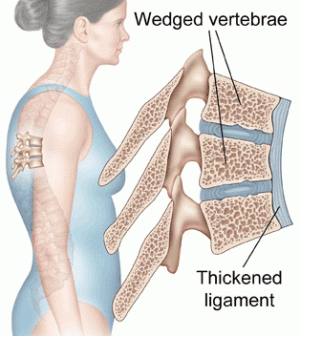Scheuermann’s disease is a developmental disorder of the spine and is also known as juvenile osteochondrosis of the spine and Calvé disease. Simply put, it is when one side of the vertebrae body grows normally, and the other grows more slowly or abnormally (this is called “wedging”). It usually occurs in the upper back, but can also be found in the lower back.
Scheuermann’s Disease
What is it?
Causes And Symptoms
- Scheuermann’s Disease Runs In Families. There Is No Clear Indication That Either Gender Is More Prone To Getting It. While The Exact Cause Is Unknown, There Are Factors Which Can Increase The Likelihood Of It. These Include Endocrine Disorders, Malabsorption, Juvenile Osteoporosis, And Biomechanical Factors.
- Symptoms Usually Consist Of Pain In And Around The Thoracic (Upper Back) Spine And An Increased Bend In The Mid Or Upper Back. The Range Of Movement Can Be Restricted, Especially In Extension (Bending Backwards).

Diagnosis
A simple X-ray is sufficient to make a firm diagnosis. The classic wedging of the thoracic vertebrae is easily seen. An MRI will show additional detail if such is needed. The picture below illustrates what is meant by “wedging” of the vertebrae.
What Treatments Are Available?
Non-surgical treatment first consists of resting, and managing and relieving pain. No-surgical treatment can be done using painkillers and things like ice therapy. You also have to avoid heavy loading of the thoracic spine and strong bending exercises.
Once the pain is under control it is time to restore range of movement and strength; this may include using a back brace on top of whatever stretches and exercises you do. After that, there’s nothing to stop you from returning to full activity, even sports. However, you may need further work and guidance to regain full function if you want to return to a particular physical activity which requires a lot of twisting and bending.
Long periods of rest can lead to de-conditioning, so exercises to regain activity or sport-specific strength will be useful and welcome. Then it is a matter of preventing future problems. Strong core muscles and good flexibility in your back, which help maintain good posture and control over the vertebra, are key to preventing future problems. All this should be done under the guidance of a physiotherapist.
Spinal fusion surgery may be needed if the disease has progressed to the point where non-surgical means will not be enough to manage the pain or correct the deformity. Surgical fusion rarely happens, but if that is looking like your best option, have no fear. Since Scheuermann’s disease often occurs in the thoracic spine, there is no worry that range of movement will be affected after surgery – there is little motion in that area anyway. It also does not typically lead to pain later in life.
More good news: Once an individual has stopped growing, the disease does not typically get worse.
Prognosis
The pain from Scheuermann’s disease does eventually pass, and the majority of patients will have no further trouble. Some would have a reduced range of movement, as well as an ongoing postural issue if the disease caused significant kyphosis (bending). Speak to your physiotherapist for further information.
Prevention
Unfortunately, there’s nothing you can do to prevent Scheuermann’s disease since on top of being hereditary, there is not a clear inheritance pattern. The best thing you can do is get it detected early and treated as early as possible.

New Client Offer - 10% OFF
Are you in pain? Not sure if we can help you?
Book your initial appointment and receive 10% off any service!